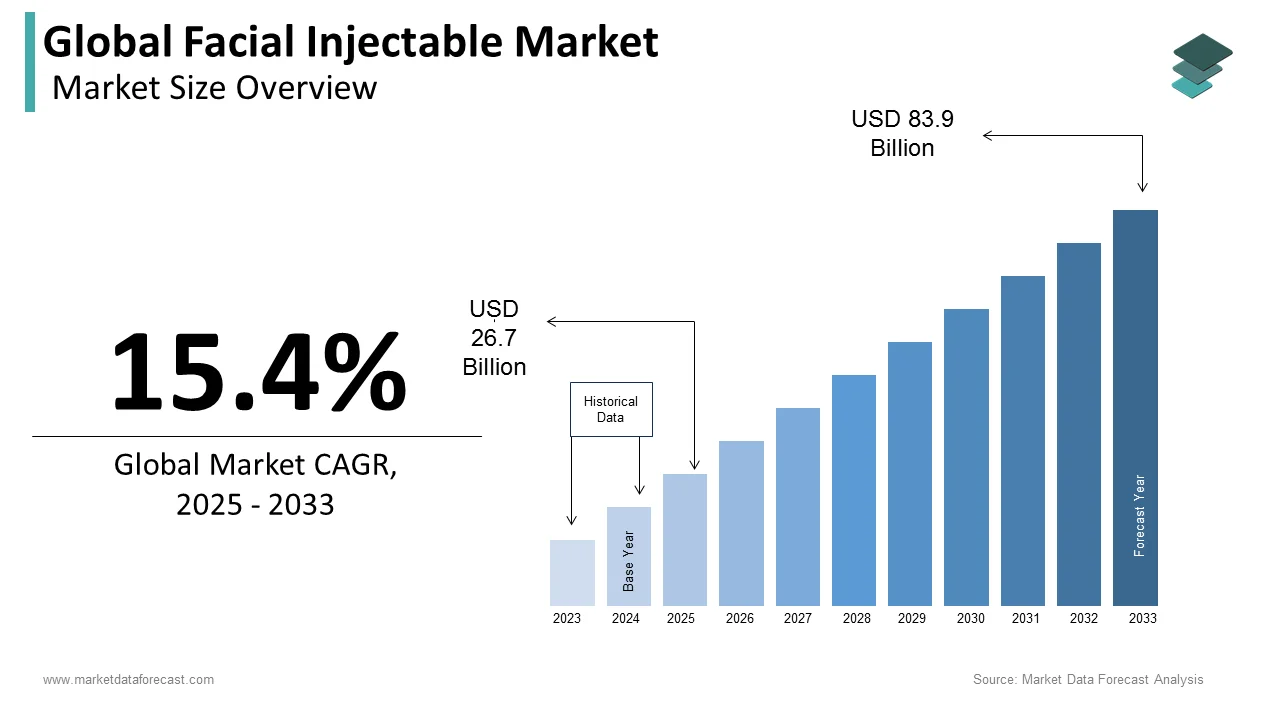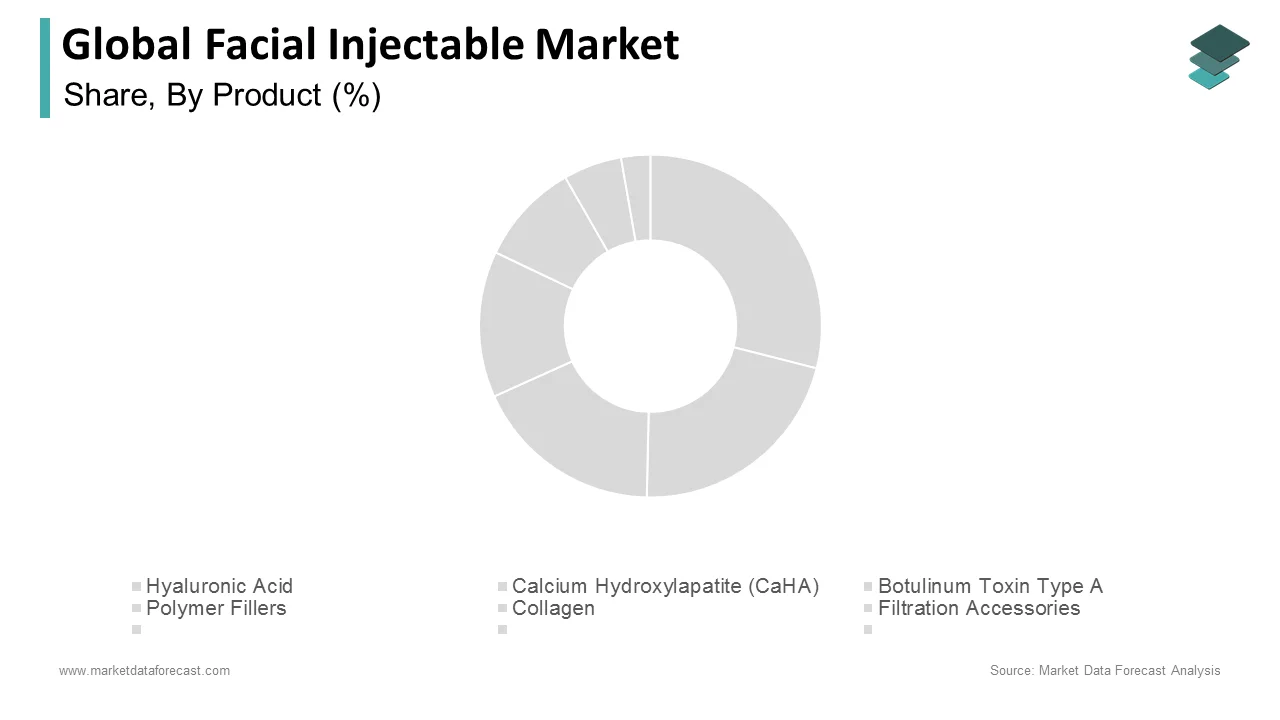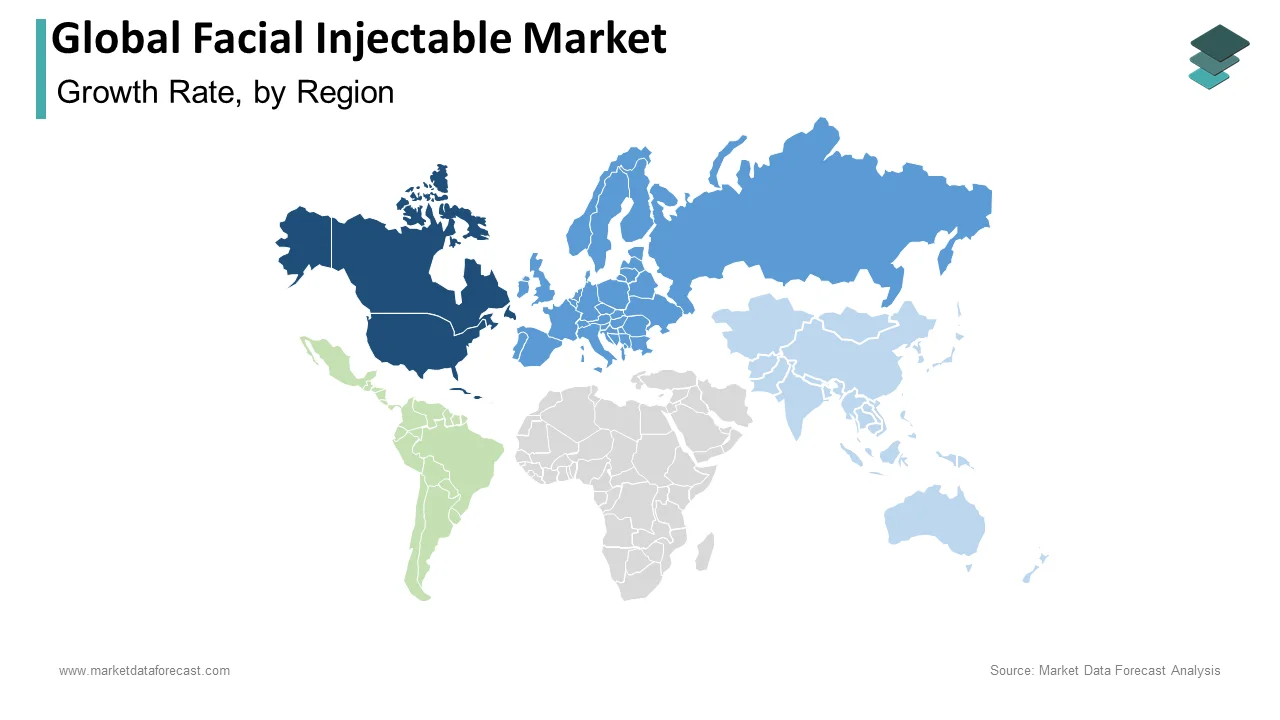Global Facial Injectable Market Size, Share, Trends & Growth Forecast Report By Product (Hyaluronic Acid, Calcium Hydroxylapatite (CaHA), Botulinum Toxin Type A, Polymer Fillers and Collagen), Application (Therapeutics and Aesthetics (Lip Augmentation, Acne Scar Treatment, Face Lift, Face Line Correction, Lipoatrophy Treatment and Others) and Region (North America, Europe, Asia-Pacific, Latin America, Middle East and Africa), Industry Analysis From 2025 To 2033.
Global Facial Injectable Market Size
The global facial injectable market was worth US$ 23.11 billion in 2024 and is anticipated to reach a valuation of US$ 83.9 billion by 2033 from US$ 26.7 billion in 2025, and it is predicted to register a CAGR of 15.4% during the forecast period 2025-2033.

Facial injectables are dermal injections used in cosmetic procedures for various purposes based on the consumers' requirements. For instance, as the human skin ages, it starts to sag and grows thinner, and to avoid this sagging of the skin and to smoothen the wrinkles on the face, these injectables are used for a youthful-looking face. In addition, fillers can be used on various parts of the face, like the cheeks, lips, forehead, chin, etc., to give the facial features more definition and a symmetrical structure. There are commonly four types of dermal fillers used in cosmetology; they are hyaluronic acid (HA), Calcium hydroxylapatite (CaHA), Poly-L-lactic acid (PLLA), and Polymethylmethacrylate (PMMA). Dermal procedures require thorough preparations as the skin can be susceptible, and the filler injections are given right under the skin to make the area plump. The fillers can have side effects and even cause infections if given without proper advice and testing.
MARKET DRIVERS
The growing concern for aesthetic appearances among people is one of the major factors propelling the growth of the facial injectable market.
Facial fillers are a relatively more straightforward cosmetic procedure with minor procedures or recovery times. Therefore, the ease of the process promotes the popularity of the market. The market for facial injectables is in demand due to the growing male populace's interest in aesthetic appearance. In addition, the popularity of the botulinum toxin and the effects of injections in eradicating fine lines, wrinkles, and signs of aging are pushing the market's growth. According to the American Society of Plastic Surgeons, in 2017 alone, 2.7 million facial filler operations were performed, an improvement of 3% over the previous year.
In addition, facial filler effects are almost immediate and show after only a few hours of the procedure. The growing popularity of minimally invasive facial procedures and many plastic surgeons and clinics fuel the market's growth rate. Furthermore, constant approvals from the FDA, rising geriatric populations, and growing disposable income rates worldwide are resulting in market growth.
The growing awareness regarding the benefits of facial injectables is anticipated to promote the market’s growth rate.
Facial injectables have several advantages, which are why they are highly preferred in the cosmetic industry. Facial injectables help reduce fine lines and wrinkles and even enhance some parts of the face for months or even years with a minimally invasive procedure that does not take too long. Facial injections help improve the collagen and elastin content in the skin, making it feel more youthful and fresher. The procedures significantly boost the patients' confidence by enhancing their natural appearance. Additionally, facial injections are an effortless procedure. Therefore, you can have multiple combinations of fillings in one sitting without significant side effects. Initial redness and swellings caused usually take minimal time to recover, and you do not need frequent visits to the doctor for follow-ups.
Furthermore, facial injections are the least noticeable change to your appearance. They give you a natural aesthetic appearance, and others often can't tell what procedures you are getting done. These injectables are also a good option for people who have suffered traumatic experiences and have scars on the face, as this treatment can help cover scars.
The growing popularity of the facial injectables market drives the market growth.
The recent interest in various facial fillers and alterations drives the market's growth rate. For instance, advancements like lip fillers like Botox and RHA fillers to achieve a more aesthetic shape to the face, like cupids, bow lips, and contoured facial structure. In addition, the American Society of Plastic Surgeons reported that more than 7.4 million injections of botulinum toxin type A and 2.6 million injections of soft-tissue fillers were carried out in 2018. Some of the new neurotoxins in the field are daxibotulinum toxin by revance and bonti botulinum toxin by allergan. Additionally, the advancements in facial procedures are supporting the market's growth. For example, some new techniques being invented are rhinoplasty with no scares left behind, minimally invasive anti-aging procedures, fat transferring, micro-needling, and others. Restylane Kysse by Galderma, and Teoxane Resilient Hyaluronic RHA fillers, are two advanced skin filler products launched in 2020 with individual advantages to each product.
MARKET RESTRAINTS
Although facial injections have several advantages, several risks are associated with the procedure and many guidelines must be followed for a safe procedure. The FDA has cleared the use of facial injections for wrinkle and fine line reduction, lip plumping, jaw line, cheek, chin, under-eye treatments, fat restoration, acne, and scars; however, even the approved procedures have several side effects post-procedure like redness, swelling, bruising, tenderness, pain, rashes, itchiness. Etc. Additionally, these procedures are not for everyone, as some people like pregnant ladies, lactating mothers, patients with bleeding disorders and specific allergies, and others. It is, therefore, extremely essential to meet with a professional plastic surgeon for these procedures.
Furthermore, there are several procedures the FDA prohibits, like fillers for breasts, butt, body contouring, etc., which, if performed, can result in long-standing illnesses or even death. In addition, there can be complications if the filler is accidentally injected into the bloodstream, causing the area's tissues to have necrosis (death). Finally, since botox and facial fillers are temporary procedures, side effects could be weakening facial muscles and drooping of the eyebrows and eyelids.
REPORT COVERAGE
|
REPORT METRIC |
DETAILS |
|
Market Size Available |
2024 to 2033 |
|
Base Year |
2024 |
|
Forecast Period |
2025 to 2033 |
|
CAGR |
15.4% |
|
Segments Covered |
By Product, Application, End-user, Generation, and Region. |
|
Various Analyses Covered |
Global, Regional, and country-level analysis; Segment-Level Analysis, DROC; PESTLE Analysis; Porter’s Five Forces Analysis, Competitive Landscape; Analyst Overview of Investment Opportunities |
|
Regions Covered |
North America, Europe, APAC, Latin America, Middle East & Africa |
|
Market Leaders Profiled |
Galderma, Merz Pharma, Allergan, Integra Lifesciences, Valeant Pharmaceuticals, Sanofi, Suneva Medical, Sinclair, Scivision Biotech In, and Others. |
SEGMENTAL ANALYSIS
By Product Insights

Based on product, the botulinum Toxin Type A segment is expected to have the most dominant share of the global market during the forecast period owing to the rising demand for facial fillers to reduce signs of aging like fine lines and wrinkles, especially in middle-aged and older populations. Additionally, the rapid approvals of botox-related products are surging the segment's demand.
However, the hyaluronic acid segment is also expected to grow significantly during the forecast period due to rising demand as HLA helps restore moisture and the skin's plumpness.
By Application Insights
The aesthetics segment is expected to dominate the market during the forecast period due to the growing preference toward aesthetic procedures like wrinkles and fine lines removals, lip fillers, face lifters, face shaping, etc. In addition, the growing demand for different facial augmentation and increasing disposable incomes are expected to drive market growth.
However, the therapeutics segment is also expected to have a sizable revenue during the forecast period due to increasing applications of facial injectables in various medical conditions like Meige's syndrome, Blepharospasm, Focal hyperhidrosis, etc.
By End-User Insights
The dermatology clinics segment is expected to dominate the market during the forecast period because most aesthetic procedures are performed in these centers. In addition, many of these procedures do not require continuous monitoring or a long recovery time. Therefore, patients prefer to visit these centers instead of hospitals.
However, hospitals and ambulatory care centers are expected to have the second-largest revenue in the market due to growing demand and influx of patients.
By Generation Insights
The boomers and millennials generations are expected to dominate the market revenue as they are now reaching the old and Middle Ages requiring such procedures.
However, the latest trend of internet penetration and the building insecurities in the younger generations are also enabling revenue for the Gen X generations.
REGIONAL ANALYSIS

The North American region is anticipated to hold the major share of the global market during the forecast period owing to the growing aging population from North American countries such as the U.S. and Canada, the introduction of new products by major market players, the growing awareness of various healthcare issues, the high demand for aesthetic procedures, the use of different surgical techniques, and technological developments in cosmetic operations, Botox injection usage is rising, face injectables are receiving more regulatory approval, and favorable reimbursement schemes further promoting the growth of the market in North America.
The European Region is anticipated to grow at a healthy CAGR in the coming years owing to the growing awareness, increasing disposable income, and growing R&D activities around facial injectables among countries such as the U.K., France, and Germany. In addition, the growing number of cosmetic procedures being performed in the Region and the establishment of several key market players also support market growth.
However, the Asia-Pacific is also expected to have significant growth during the forecast period due to rising disposable incomes, more lavish spending on healthcare infrastructure, the introduction of innovative products, rising income from developing nations, and increasing medical tourism. Additionally, the Region is developing due to revenue from countries like India, Japan, China, South Korea, etc.
Although MEA and Latin America are expected to have low market growth compared to other regions, some countries like Brazil and Mexico are expected to have a sizable share in the market.
KEY MARKET PLAYERS
Galderma, Merz Pharma, Allergan, Integra Lifesciences, Valeant Pharmaceuticals, Sanofi, Suneva Medical, Sinclair, and Scivision Biotech Inc. are some of the dominating companies operating in the global facial injectable market.
RECENT HAPPENINGS IN THE MARKET
- In December 2022, Aduhelm's FDA clearance and decisions about its pricing and promotion were all the subject of a damning congressional report that labeled discussions between Biogen and the agency as "inappropriate" and "atypical" has been released. Yet, despite the panel's advice, the FDA nonetheless gave Aduhelm the green light. In protest, several members left the group.
- In November 2022, formerly a team member of Dr. 90210 in Beverly Hills, Marissa Abdo, MS, RN, CANS, established her practice, Aesthetic IQ, in Scottsdale to help patients achieve their full potential through specialized facial injectable treatments like Botox Dysport, Juvederm and Restylane dermal fillers, and Sculptra Aesthetic.
- In December 2022, with their recent partnership with Merz Aesthetics, Liquivida, a pioneer in vitamin IV therapy, medical aesthetics, and age control solutions, expanded its product line. The business caters to individuals who want to appear their best as they age by consulting with the most excellent doctors and estheticians.
MARKET SEGMENTATION
This market research report on the global facial injectable market has been segmented and sub-segmented based on the product, application, end-user, generation, and region.
By Product
- Hyaluronic Acid
- Calcium Hydroxylapatite (CaHA)
- Botulinum Toxin Type A
- Polymer Fillers
- Polymethylmethacrylate beads
- Poly-L-Lactic Acid
- Collagen
By Application
- Therapeutics
- Aesthetics
- Lip Augmentation
- Acne Scar Treatment
- Face Lift
- Face Line Correction
- Lipoatrophy Treatment
- Others
By End-User
- Dermatology Clinics
- Hospitals
- Others
By Generation
- Millennials
- boomers
- Gen X
By Region
- North America
- Europe
- Asia-Pacific
- Latin America
- Middle East and Africa
Frequently Asked Questions
Does this report include the impact of COVID-19 on the facial injectable market?
The global facial injectable market is anticipated to be worth USD 83.9 billion by 2033.
Which segment by product led the facial injectable market in 2024
Based on product type, the botulinum toxin type A segment had the leading share of the market in 2024.
What are the companies playing a key role in the facial injectable market?
Companies playing a major role in the global facial injectable market are Galderma, Merz Pharma, Allergan, Integra Lifesciences, Valeant Pharmaceuticals, Sanofi, Suneva Medical, Sinclair, and Scivision Biotech Inc.
Related Reports
Access the study in MULTIPLE FORMATS
Purchase options starting from $ 2500
Didn’t find what you’re looking for?
TALK TO OUR ANALYST TEAM
Need something within your budget?
NO WORRIES! WE GOT YOU COVERED!
Call us on: +1 888 702 9696 (U.S Toll Free)
Write to us: [email protected]
